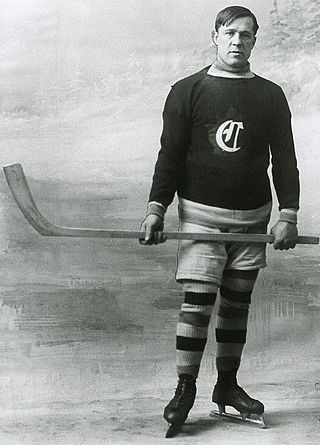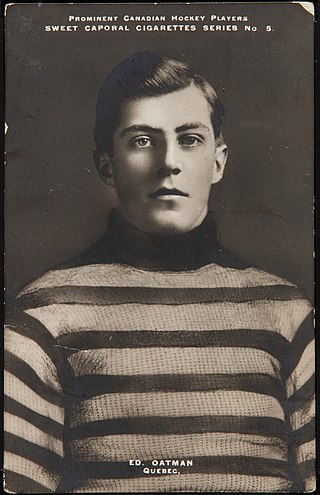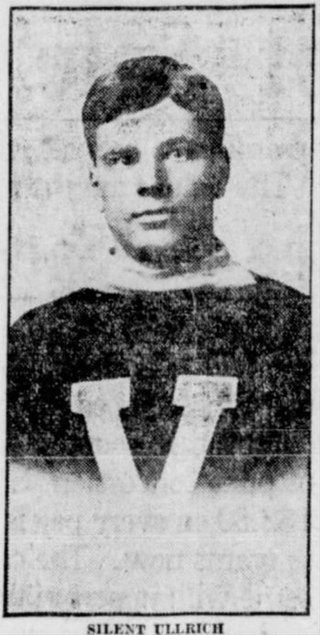The National Hockey Association (NHA), initially the National Hockey Association of Canada Limited, was a professional ice hockey organization with teams in Ontario and Quebec, Canada. It is the direct predecessor of today's National Hockey League (NHL), and much of the business processes of the NHL today are based on the NHA. Founded in 1909 by Ambrose O'Brien, the NHA introduced 'six-man hockey' by removing the 'rover' position in 1911. During its lifetime, the league coped with competition for players with the rival Pacific Coast Hockey Association (PCHA), the enlistment of players for World War I and disagreements between owners. The disagreements between owners came to a head in 1917, when the NHA suspended operations in order to get rid of an unwanted owner, Eddie Livingstone.

Curtis Lester Patrick was a Canadian professional ice hockey player and coach associated with the Victoria Aristocrats/Cougars of the Pacific Coast Hockey Association, and the New York Rangers of the National Hockey League (NHL). Along with his brother Frank Patrick and father Joseph Patrick, he founded the PCHA and helped develop several rules for the game of hockey. Patrick won the Stanley Cup six times as a player, coach and manager.

Defence or defense in ice hockey is a player position that is primarily responsible for preventing the opposing team from scoring. They are often referred to as defencemen, D, D-men or blueliners. They were once called cover-point.
The Pacific Coast Hockey Association (PCHA) was a professional ice hockey league in western Canada and the western United States, which operated from 1911 to 1924 when it then merged with the Western Canada Hockey League (WCHL). The PCHA was considered to be a major league of ice hockey and was important in the development of the sport of professional ice hockey through its innovations.
The Seattle Metropolitans were a professional ice hockey team based in Seattle, Washington, playing in the Pacific Coast Hockey Association (PCHA) from 1915 to 1924. During their nine seasons, the Metropolitans were the PCHA's most successful franchise, as they went 112–96–2 in their nine years as a franchise. The Metropolitans also won the most regular season PCHA championships, winning five times, with Seattle finishing second on three other occasions. The Metropolitans played their home games at the 2,500 seat Seattle Ice Arena located downtown at 5th and University.

The Victoria Cougars were a major league professional ice hockey team that played in the Pacific Coast Hockey Association (PCHA) from 1911 to 1924 under various names, and in the Western Hockey League (WHL) from 1924 to 1926. The team was based in Victoria, British Columbia, and won the Stanley Cup in 1925, becoming the final non-NHL team to win the Cup.

Joseph George Didier "Cannonball" Pitre was a Canadian professional ice hockey player. Nicknamed "Cannonball," he was renowned for having one of the hardest shots during his playing career. One of the first players to join the Montreal Canadiens, Pitre and his teammates' French-Canadian heritage led to the team being nicknamed The Flying Frenchmen. His teammates on the Canadiens included Jack Laviolette and Newsy Lalonde.

Frank Corbett "Flash" Foyston was a Canadian professional ice hockey player and coach. Foyston was a member of Stanley Cup championship teams three times: with the Toronto Blueshirts in 1914, the Seattle Metropolitans in 1917, and the Victoria Cougars in 1925. While with the Metropolitans, he twice led the Pacific Coast Hockey Association (PCHA) in goals. After his retirement from playing, Foyston became a minor league head coach. He was inducted into the Hockey Hall of Fame in 1958.

Frederick Wellington "Cyclone" Taylor, MBE was a Canadian professional ice hockey player and civil servant. A cover-point and rover, he played professionally from 1906 to 1922 for several teams, and is most well-known for his time with the Vancouver Millionaires of the Pacific Coast Hockey Association (PCHA). Acknowledged as one of the first stars of the professional era of hockey, Taylor was recognized during his career as one of the fastest skaters and most prolific scorers, winning five scoring championships in the PCHA. He also won the Stanley Cup twice, with Ottawa in 1909 and Vancouver in 1915, and was inducted into the Hockey Hall of Fame in 1947.

John Phillip "Jack" Walker was a Canadian professional ice hockey forward who played for the Toronto Blueshirts, Seattle Metropolitans, Victoria Cougars, and Detroit Cougars. He played in all the big professional leagues at the time: the National Hockey Association (NHA), Pacific Coast Hockey Association (PCHA), Western Canada Hockey League (WCHL), and National Hockey League (NHL).

Francis Alexis Patrick was a Canadian professional ice hockey player, head coach, manager, and executive. Along with his brother Lester, he founded the Pacific Coast Hockey Association (PCHA), the first major professional hockey league in Western Canada. Patrick, who also served as president of the league, took control of the Vancouver Millionaires, serving as a player, coach, and manager of the team. It was in the PCHA that Patrick would introduce many innovations to hockey that remain today, including the blue line, the penalty shot, and tracking assists, among others.
The 1911–12 NHA season was the third season of the National Hockey Association (NHA). Four teams played 18 games each. The Quebec Bulldogs would win the league championship and take over the Stanley Cup.

Charles M. Cotch was a Canadian ice hockey left winger. He played two seasons in the Pacific Coast Hockey Association with the Vancouver Maroons and one season in the National Hockey League with the Hamilton Tigers and Toronto St. Pats between 1922 and 1925. Playing mainly as a spare player, Cotch appeared in 29 games in the PCHA and 12 in the NHL, and played in the 1923 and 1924 Stanley Cup playoffs with the Maroons.

The 1915 Stanley Cup Finals was played from March 22–26, 1915. The Pacific Coast Hockey Association (PCHA) champion Vancouver Millionaires swept the National Hockey Association (NHA) champion Ottawa Senators three games to none in a best-of-five game series. The finals were played in Vancouver, with games one, three and five played under PCHA rules. The Millionaires became the first team from the PCHA to win the Cup. This was the second Stanley Cup championship series between the champions of the NHA and the PCHA and the first held in a PCHA rink.
The 1918 Stanley Cup Finals was contested by the National Hockey League (NHL) champion Toronto and the Pacific Coast Hockey Association (PCHA) champion Vancouver Millionaires. In a series held entirely in Toronto, the Toronto team won the series by three games to two in the best-of-five game series to win the Stanley Cup. It was the first series contested by the new NHL and subsequently the first Stanley Cup win by the Toronto NHL franchise team.

Edward Cole Oatman was a Canadian professional ice hockey player. He was among the elite goal scorers of his era. Among his 32 years (1907–39) playing professional ice hockey, Oatman was named an all-star for ten consecutive seasons by the Pacific Coast Hockey Association (PCHA). He was a star with the Quebec Bulldogs when it won the 1912 Stanley Cup. Oatman played with clubs that won five league championships, and he was a successful coach and captain of five different hockey teams. His brother Russell also played professional ice hockey.

The 1912 PCHA season was the first season of the now defunct men's professional ice hockey Pacific Coast Hockey Association (PCHA), a league founded on December 7, 1911. The three teams, all based in British Columbia, Canada, were to play a sixteen-game schedule, but one game was cancelled. The season ran from January 2 to March 19, 2012, ending with the New Westminster Royals as the first PCHA champions. In February, the PCHA had issued a challenge to the two-year-old National Hockey Association (NHA) to have the two leagues' champions play a series for the Stanley Cup, but the season ended too late for the Royals to travel east to face the NHA champion Quebec Bulldogs, who retained the Stanley Cup without further challenge for the 1911–12 season.
The 1914–15 PCHA season was the fourth season of the professional men's ice hockey Pacific Coast Hockey Association league. Season play ran from December 8, 1914, until March 9, 1915. The schedule was made for each team to play 18 games, but like the previous three seasons, one game was cancelled. The Vancouver Millionaires club were the PCHA champions. After the season the club faced off against the Ottawa Senators, NHA champions for the Stanley Cup, winning the series and becoming the first west-coast team to win the Cup.

Thomas Wilfred "Smokey, Fred" Harris was a Canadian professional ice hockey player. Harris played in the Pacific Coast Hockey Association (PCHA), the National Hockey League (NHL) and the Western Canada Hockey League (WCHL). Harris was born in Port Arthur, Ontario. His brother Henry was also a professional ice hockey player. Harris scored the first goal in Boston Bruins' franchise history.

John Daniel "Jack, Silent" Ulrich was a Canadian professional ice hockey right winger. Ulrich, who was deaf-mute, played professionally with the Vancouver Millionaires and the Victoria Aristocrats in the Pacific Coast Hockey Association in 1912–1914. He also played for the Montreal Wanderers and the Toronto Blueshirts in the National Hockey Association in 1914–1916.
















